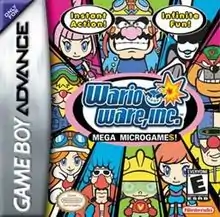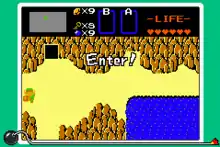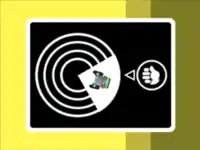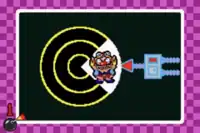WarioWare, Inc.: Mega Microgames!
WarioWare, Inc.: Mega Microgames!,[lower-alpha 1] stylized as WarioWare, Inc.: Mega Microgame$! and known in the PAL region as WarioWare, Inc.: Minigame Mania, is a minigame compilation party video game for the Game Boy Advance. The debut title in the WarioWare series, the game is about rapid completion of "microgames", short minigames given to the player consecutively and with increasing speed per each game complete. Developed by Nintendo R&D1 and published by Nintendo, the game was inspired by the "Sound Bomber" mode of Mario Artist: Polygon Studio for the Nintendo 64DD. The music and sound effects (including Wario's voice clips) were recycled from Wario Land 4. The game was produced by Takehiro Izushi and directed by Hirofumi Matsuoka. Matsuoka was also the director of Polygon Studio. Mega Microgames! was released in 2003; in Japan in March, in North America and Europe in May and in Australia in June.
| WarioWare, Inc.: Mega Microgames! | |
|---|---|
 North American box art | |
| Developer(s) | Nintendo R&D1 |
| Publisher(s) | Nintendo |
| Director(s) | Hirofumi Matsuoka |
| Producer(s) | Takehiro Izushi |
| Designer(s) | Ko Takeuchi Goro Abe Ryutaro Takahashi |
| Programmer(s) | Kazuyoshi Ohsawa |
| Artist(s) | Ko Takeuchi |
| Composer(s) | Ryoji Yoshitomi Kyoko Miyamoto |
| Series | Wario |
| Platform(s) | Game Boy Advance |
| Release | |
| Genre(s) | Action, rhythm |
| Mode(s) | Single-player, multiplayer |
Upon its release, WarioWare, Inc.: Mega Microgames! received critical acclaim, winning GameSpot's Editor's Choice Award and Most Innovative Game Award of 2003, among other awards. The game went on to receive a multiplayer-focused remake called WarioWare, Inc.: Mega Party Games! on the GameCube.
The game went on to spawn the WarioWare series of video games, which all have the same formula of gameplay as the debut title, with the exception of Game & Wario. "Pyoro" and "Paper Plane", two bonus minigames that appear in Mega Microgames!, were re-worked into two full titles for the Nintendo DS and sold as DSiWare as Bird & Beans and Paper Airplane Chase. In addition, some of the microgames featured in Mega Microgames! also appear in WarioWare Gold. The game has also been re-released through the Virtual Console on Wii U and Nintendo 3DS.
Gameplay



WarioWare's core gameplay principles revolve around the concept of "microgames", minigames that must be completed within a demanding time limit.[1] In a stage, microgames are presented to the player consecutively, and as the player keeps playing, the game speeds up, making microgames' time limits shorter and forcing the player to complete them faster.[2] If the player completes a microgame, the game moves onto the next one, while if the player fails a microgame, by either losing the game or running out of time, one of four lives will be deducted.[3] If the player loses all four of their lives, the game will end and the player's score (the number of microgames played) will be saved if it is one of their best three scores.[4]
At the end of a set number of microgames, the player must complete a "boss stage"; a longer microgame without a set time limit.[5] In these microgames, the player has the opportunity to gain a life back if they have lost one.[6] Mega Microgames! has nine stages, each revolving around Wario or one of his associates in a plot scenario.[6] Each stage also has a general theme the microgames present in it pertain to, such as "Sports" or "Nintendo Classics".[4] In addition to microgames, the player is also able to gain access to additional bonus minigames to play.[7]
Mega Microgames! contains 213 microgames, split over 9 stages, each with different themes and following the story of different characters, all associates of Wario whom are contacted by him to make games for him to sell as part of his new "game" company.[7] The game's story is conveyed through short subtitled cutscenes before and after stages.[8] In addition to microgame stages, the player can unlock "remix" stages which feature microgames from past stages in it, as well as other bonus stages, which feature all microgames, but change elements like speed or microgame difficulty.[7]
The player is also able to gain access to other bonus minigames if they beat or get a high score in certain main stages. The minigames are typically variations on concepts of existing microgames from main stages, and take the form of both single-player games and multiplayer games.[8]
Development
WarioWare's inception began during the development of Mario Artist: Polygon Studio, a successor to Mario Paint being developed for the Nintendo 64DD; a game where players could create three-dimensional models and animate them. A feature of Polygon Studio was a mode called "Sound Bomber", where the player completes rapid consecutive "microgames". This idea would be re-used for Mega Microgames! for a full-fledged video game.[9] In addition, many of the mini-games in Polygon Studio bear heavy resemblance to some microgames found in Mega Microgames!.[10]
The development team used post-it notes in order to come up with microgame ideas; whenever someone had an idea for a microgame, they would write it down on a note and stick it to the director's table. The game became well known around the department, as other members not working on the game gave their ideas as well.[9] Microgames that were too obscene or "too Japanese" were cut to make sure all people playing could understand the game.[9] As individual programmers coded individual microgames, each microgame has a vastly different visual style.[9]
At first, the game was developed without the knowledge or consent of Nintendo. A team inside Nintendo R&D1 came up with the idea and started developing the game for the Game Boy Advance without their manager's knowledge. Later, they presented the game to their manager, who said "okay" to the idea.[9] According to Yoshio Sakamoto, Wario was chosen as the game's protagonist as he "is always doing stupid things and is really idiotic".[9]
The game was re-released on the Wii U and Nintendo 3DS Virtual Console.[11]
Reception
| Aggregator | Score |
|---|---|
| Metacritic | 89/100[12] |
| Publication | Score |
|---|---|
| Game Informer | 7.5/10[13] |
| GameSpot | 9.1/10[2] |
| GameSpy | 95/100[4] |
| IGN | 9/10[3] |
| Nintendo Life | 9/10[5] |
| Nintendo Power | 4.6/5[14] |
| Nintendo World Report | 9.5/10[6] |
Mega Microgames! has won numerous awards and received critical acclaim. It was voted the winner of the Edge Award at the Edinburgh International Games Festival in 2004 by a panel of videogames industry members, academics, and journalists.[15]
At GameSpot, it was awarded the Editor's Choice Award, "Game Boy Advance Game of the Month" prize and was nominated for its "Best and Worst" of 2003 in the "Most Innovative Game" category.[16][17][18]
Reviewers wrote enthusiastically about the game. Jeff Gerstmann from GameSpot gave it a 9.1 out of 10 and praised the game for its portability, being able to play it in "short bursts" and being able to return to it again and again. Craig Harris from IGN said that the sheer number of minigames, its simplicity, and replay value made the game original and great, and gave it a 9.0.[3]
Edge ranked the game #40 on its list of "The 100 Best Games To Play Today", stating "almost every minigame is a masterclass in how to instantly captivate with clear goals and a captivating alchemy of sound, image and control."[19]
Remakes and re-releases
WarioWare, Inc.: Mega Party Games!
Mega Microgames! was remade for the GameCube as WarioWare, Inc.: Mega Party Games!, as a more multiplayer focused game than the original. The game features all of the same microgames as the Game Boy Advance version, but the microgames are set up in competitive environments for two to four players rather than an environment for one player.
DSiWare
Two unlockable mini-games from this title, Paper Plane and Pyoro, have been released for the Nintendo DSi's DSiWare digital distribution service.
Paper Airplane Chase
Paper Airplane Chase[lower-alpha 2], known in Europe and Australasia as Paper Plane, was released in Japan on December 24, 2008, in Europe and Australasia on April 3, 2009, and in North America on April 27 during the same year. The game plays the same as in its original title. There are three modes - the first is Endless, which places the player in a randomly generated course, requiring him or her to guide a paper airplane through it as it descends, attempting to get as far down as possible; Time Attack, which places the player in pre-created tracks, requiring them to get down to a certain point as fast as possible; and Race Mode, a two-player competition that is played on one DSi, with one player using the d-pad and the other using the face buttons. There are a total of eight courses in the game.
Bird & Beans
Bird & Beans[lower-alpha 3], known in PAL regions as Pyoro, features both Pyoro and Pyoro 2 from the original GBA version. Both play mostly the same as the original versions, although the play area is now wider. The first requires the player to eat falling beans by shooting Pyoro's tongue in an upward diagonal direction. If a bean lands on the ground, it destroys part of the floor, limiting how much the player can move Pyoro. If the player eats a differently colored bean, it will restore one of the blocks, and eating a flashing bean restores many, if not all, lost blocks and destroys all on-screen beans. The further Pyoro's tongue is extended, the more points are awarded. If a seed lands on Pyoro, the game ends. In the second game, the player must shoot seeds at the falling beans. More points are awarded when two or more are taken out at the same time. Bird & Beans does not have any additional modes.
Virtual Console
In December 2011, Mega Microgames! and nine other Game Boy Advance games were released to Nintendo 3DS Ambassadors, which were users who purchased and registered their 3DS systems prior to a specific date in their home markets.
The game was later released on the Wii U Virtual Console on April 3, 2014 in Japan and April 10, 2014 in North America and Europe.
Notes
References
- GameSpot Staff (9 April 2003). "WarioWare Inc. Mega Microgame$ impressions". GameSpot. Retrieved 13 June 2018.
- Gerstmann, Jeff (27 May 2003). "WarioWare Inc.: Mega MicroGames Review". GameSpot. Retrieved 13 June 2018.
- Harris, Craig (22 May 2003). "Wario Ware, Inc: Mega Microgames". IGN. Retrieved 25 June 2018.
- Turner, Benjamin (25 May 2003). "WarioWare, Inc.: Mega Microgame$ (GBA)". GameSpy. Archived from the original on 27 May 2003. Retrieved 12 August 2018.
- Walker, Joe (12 January 2012). "WarioWare, Inc.: Mega Microgame$! Review (3DS eShop / GBA)". Nintendo Life. Retrieved 25 June 2018.
- Sklens, Mike (22 June 2003). "WarioWare Inc.: Mega MicroGame$". Nintendo World Report. Retrieved 12 August 2018.
- Nintendo Research & Development 1 (21 March 2003). WarioWare, Inc.: Mega Microgames! (Game Boy Advance). Nintendo.
- "Nintendo R&D1 Interview". Kiziko Archives. 7 April 2006. Retrieved 13 June 2018.
- [data unknown/missing]. Mario Artist: Polygon Studio.CS1 maint: multiple names: authors list (link)
- Sinclair, Brendan (16 December 2011). "3DS Ambassador GBA games released". GameSpot. Retrieved 13 June 2018.
- "WarioWare, Inc.: Mega Microgame$!". Metacritic. Retrieved 13 June 2018.
- "Wario Ware, Inc: Mega Microgames Game Informer Review".
- "WarioWare, Inc.: Mega Microgame$". Nintendo Power. 169: 135. June 2003.
- "GameBoy mini-games take top prize". BBC News. 14 August 2004.
- The Editors of GameSpot (June 1, 2003). "GameSpot's Month in Review: May 2003". GameSpot. Archived from the original on April 8, 2004.
- "Editor's Choice Games". GameSpot. 2003. Retrieved 25 June 2018.
- "GameSpot's Best and Worst of 2003 - Most Innovative Game Nominees". GameSpot. 26 December 2003. Archived from the original on 26 December 2003. Retrieved 25 June 2018.
- "The 100 Best Games To Play Today". Edge. 9 March 2009. Archived from the original on 26 September 2012. Retrieved 25 June 2018.